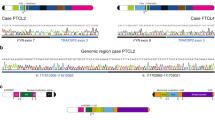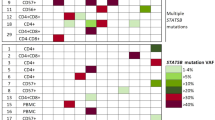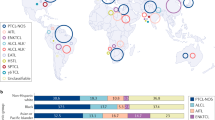Abstract
Peripheral T-cell lymphomas (PTCLs) comprise a heterogeneous group of mature T-cell neoplasms with a poor prognosis. Recently, mutations in TET2 and other epigenetic modifiers as well as RHOA have been identified in these diseases, particularly in angioimmunoblastic T-cell lymphoma (AITL). CD28 is the major co-stimulatory receptor in T cells which, upon binding ligand, induces sustained T-cell proliferation and cytokine production when combined with T-cell receptor stimulation. We have identified recurrent mutations in CD28 in PTCLs. Two residues—D124 and T195—were recurrently mutated in 11.3% of cases of AITL and in one case of PTCL, not otherwise specified (PTCL-NOS). Surface plasmon resonance analysis of mutations at these residues with predicted differential partner interactions showed increased affinity for ligand CD86 (residue D124) and increased affinity for intracellular adaptor proteins GRB2 and GADS/GRAP2 (residue T195). Molecular modeling studies on each of these mutations suggested how these mutants result in increased affinities. We found increased transcription of the CD28-responsive genes CD226 and TNFA in cells expressing the T195P mutant in response to CD3 and CD86 co-stimulation and increased downstream activation of NF-κB by both D124V and T195P mutants, suggesting a potential therapeutic target in CD28-mutated PTCLs.
This is a preview of subscription content, access via your institution
Access options
Subscribe to this journal
Receive 12 print issues and online access
$259.00 per year
only $21.58 per issue
Buy this article
- Purchase on Springer Link
- Instant access to full article PDF
Prices may be subject to local taxes which are calculated during checkout




Similar content being viewed by others
References
A clinical evaluation of the International Lymphoma Study Group classification of non-Hodgkin's lymphoma. The Non-Hodgkin's Lymphoma Classification Project. Blood 1997; 89: 3909–3918.
Mourad N, Mounier N, Briere J, Raffoux E, Delmer A, Feller et al. Clinical, biologic, and pathologic features in 157 patients with angioimmunoblastic T-cell lymphoma treated within the Groupe d'Etude des Lymphomes de l'Adulte (GELA) trials. Blood 2008; 111: 4463–4470.
de Leval L, Rickman DS, Thielen C, Reynies A, Huang YL, Delsol G et al. The gene expression profile of nodal peripheral T-cell lymphoma demonstrates a molecular link between angioimmunoblastic T-cell lymphoma (AITL) and follicular helper T (TFH) cells. Blood 2007; 109: 4952–4963.
Iqbal J, Weisenburger DD, Greiner TC, Vose JM, McKeithan T, Kucuk C et al. Molecular signatures to improve diagnosis in peripheral T-cell lymphoma and prognostication in angioimmunoblastic T-cell lymphoma. Blood 2010; 115: 1026–1036.
Krenacs L, Schaerli P, Kis G, Bagdi E . Phenotype of neoplastic cells in angioimmunoblastic T-cell lymphoma is consistent with activated follicular B helper T cells. Blood 2006; 108: 1110–1111.
Quivoron C, Couronne L, Della Valle V, Lopez CK, Plo I, Wagner-Ballon O et al. TET2 inactivation results in pleiotropic hematopoietic abnormalities in mouse and is a recurrent event during human lymphomagenesis. Cancer Cell 2011; 20: 25–38.
Cairns RA, Iqbal J, Lemonnier F, Kucuk C, de Leval L, Jais JP et al. IDH2 mutations are frequent in angioimmunoblastic T-cell lymphoma. Blood 2012; 119: 1901–1903.
Wang C, McKeithan TW, Gong Q, Zhang W, Bouska A, Rosenwald et al. IDH2R172 mutations define a unique subgroup of patients with angioimmunoblastic T-cell lymphoma. Blood 2015; 126: 1741–1752.
Odejide O, Weigert O, Lane AA, Toscano D, Lunning MA, Kopp N et al. A targeted mutational landscape of angioimmunoblastic T-cell lymphoma. Blood 2014; 123: 1293–1296.
Palomero T, Couronne L, Khiabanian H, Kim MY, Ambesi-Impiombato A, Perez-Garcia et al. Recurrent mutations in epigenetic regulators, RHOA and FYN kinase in peripheral T cell lymphomas. Nat Genet 2014; 46: 166–170.
Sakata-Yanagimoto M, Enami T, Yoshida K, Shiraishi Y, Ishii R, Miyake Y et al. Somatic RHOA mutation in angioimmunoblastic T cell lymphoma. Nat Genet 2014; 46: 171–175.
Yoo HY, Sung MK, Lee SH, Kim S, Lee H, Park S et al. A recurrent inactivating mutation in RHOA GTPase in angioimmunoblastic T cell lymphoma. Nat Genet 2014; 46: 371–375.
Iqbal J, Wright G, Wang C, Rosenwald A, Gascoyne RD, Weisenburger DD et al. Gene expression signatures delineate biological and prognostic subgroups in peripheral T-cell lymphoma. Blood 2014; 123: 2915–2923.
Greaves P, Gribben JG . The role of B7 family molecules in hematologic malignancy. Blood 2013; 121: 734–744.
Gimmi CD, Freeman GJ, Gribben JG, Gray G, Nadler LM . Human T-cell clonal anergy is induced by antigen presentation in the absence of B7 costimulation. Proc Natl Acad Sci USA 1993; 90: 6586–6590.
Rudd CE, Schneider H . Unifying concepts in CD28, ICOS and CTLA4 co-receptor signalling. Nat Rev Immunol 2003; 3: 544–556.
Boomer JS, Green JM . An enigmatic tail of CD28 signaling. Cold Spring Harb Perspect Biol 2010; 2: a002436.
Trapnell C, Pachter L, Salzberg SL . TopHat: discovering splice junctions with RNA-Seq. Bioinformatics 2009; 25: 1105–1111.
Langmead B, Trapnell C, Pop M, Salzberg SL . Ultrafast and memory-efficient alignment of short DNA sequences to the human genome. Genome Biol 2009; 10: R25.
Trapnell C, Williams BA, Pertea G, Mortazavi A, Kwan G, van Baren MJ et al. Transcript assembly and quantification by RNA-Seq reveals unannotated transcripts and isoform switching during cell differentiation. Nat Biotechnol 2010; 28: 511–515.
Yost SE, Alakus H, Matsui H, Schwab RB, Jepsen K, Frazer KA et al. Mutascope: sensitive detection of somatic mutations from deep amplicon sequencing. Bioinformatics 2013; 29: 1908–1909.
Koboldt DC, Zhang Q, Larson DE, Shen D, McLellan MD, Lin L et al. VarScan 2: somatic mutation and copy number alteration discovery in cancer by exome sequencing. Genome Res 2012; 22: 568–576.
Kim D, Salzberg SL . TopHat-Fusion: an algorithm for discovery of novel fusion transcripts. Genome Biol 2011; 12: R72.
Therneau T 2015 A Package for Survival Analysis in S. version 2.38. Available from http://CRAN.R-project.org/package=survival.
Evans EJ, Castro MA, O'Brien R, Kearney A, Walsh H, Sparks LM et al. Crystal structure and binding properties of the CD2 and CD244 (2B4)-binding protein, CD48. J Biol Chem 2006; 281: 29309–29320.
Collins AV, Brodie DW, Gilbert RJ, Iaboni A, Manso-Sancho R, Walse B et al. The interaction properties of costimulatory molecules revisited. Immunity 2002; 17: 201–210.
van der Merwe PA, Bodian DL, Daenke S, Linsley P, Davis SJ . CD80 (B7-1) binds both CD28 and CTLA-4 with a low affinity and very fast kinetics. J Exp Med 1997; 185: 393–403.
Evans EJ, Esnouf RM, Manso-Sancho R, Gilbert RJ, James JR, Yu C et al. Crystal structure of a soluble CD28-Fab complex. Nat Immunol 2005; 6: 271–279.
Schwartz JC, Zhang X, Fedorov AA, Nathenson SG, Almo SC . Structural basis for co-stimulation by the human CTLA-4/B7-2 complex. Nature 2001; 410: 604–608.
Stamper CC, Zhang Y, Tobin JF, Erbe DV, Ikemizu S, Davis SJ et al. Crystal structure of the B7-1/CTLA-4 complex that inhibits human immune responses. Nature 2001; 410: 608–611.
Higo K, Ikura T, Oda M, Morii H, Takahashi J, Abe R et al. High resolution crystal structure of the Grb2 SH2 domain with a phosphopeptide derived from CD28. PLoS One 2013; 8: e74482.
Simone PD, Struble LR, Kellezi A, Brown CA, Grabow CE, Khutsishvili I et al. The human ITPA polymorphic variant P32T is destabilized by the unpacking of the hydrophobic core. J Struct Biol 2013; 182: 197–208.
Simone LC, Georgesen CJ, Simone PD, Wang X, Solheim JC . Productive association between MHC class I and tapasin requires the tapasin transmembrane/cytosolic region and the tapasin C-terminal Ig-like domain. Mol Immunol 2013; 49: 628–639.
Krishna SS, Aravind L, Bakolitsa C, Caruthers J, Carlton D, Miller MD et al. The structure of SSO2064, the first representative of Pfam family PF01796, reveals a novel two-domain zinc-ribbon OB-fold architecture with a potential acyl-CoA-binding role. Acta Crystallogr Sect F Struct Biol Cryst Commun 2010; 66: 1160–1166.
Kucuk C, Iqbal J, Hu X, Gaulard P, De Leval L, Srivastava G et al. PRDM1 is a tumor suppressor gene in natural killer cell malignancies. Proc Natl Acad Sci USA 2011; 108: 20119–20124.
Geiss GK, Bumgarner RE, Birditt B, Dahl T, Dowidar N, Dunaway DL et al. Direct multiplexed measurement of gene expression with color-coded probe pairs. Nat Biotechnol 2008; 26: 317–325.
Weinstein JS, Lezon-Geyda K, Maksimova Y, Craft S, Zhang Y, Su M et al. Global transcriptome analysis and enhancer landscape of human primary T follicular helper and T effector lymphocytes. Blood 2014; 124: 3719–3729.
Choi J, Goh G, Walradt T, Hong BS, Bunick CG, Chen K et al. Genomic landscape of cutaneous T cell lymphoma. Nat Genet 2015; 47: 1011–1019.
Hindson BJ, Ness KD, Masquelier DA, Belgrader P, Heredia NJ, Makarewicz AJ et al. High-throughput droplet digital PCR system for absolute quantitation of DNA copy number. Anal Chem 2011; 83: 8604–8610.
Sekulic A, Liang WS, Tembe W, Izatt T, Kruglyak S, Kiefer JA et al. Personalized treatment of Sezary syndrome by targeting a novel CTLA4:CD28 fusion. Mol Genet Genomic Med 2015; 3: 130–136.
Kataoka K, Nagata Y, Kitanaka A, Shiraishi Y, Shimamura T, Yasunaga JI et al. Integrated molecular analysis of adult T cell leukemia/lymphoma. Nat Genet 2015; 47: 1304–1315.
Kucuk C, Jiang B, Hu X, Zhang W, Chan JK, Xiao W et al. Activating mutations of STAT5B and STAT3 in lymphomas derived from gammadelta-T or NK cells. Nat Commun 2015; 6: 6025.
Bajorath J, Metzler WJ, Linsley PS . Molecular modeling of CD28 and three-dimensional analysis of residue conservation in the CD28/CD152 family. J Mol Graph Model 1997; 15: 135–139, 08-11.
Linsley PS, Brady W, Grosmaire L, Aruffo A, Damle NK, Ledbetter JA . Binding of the B cell activation antigen B7 to CD28 costimulates T cell proliferation and interleukin 2 mRNA accumulation. J Exp Med 1991; 173: 721–730.
Linsley PS, Brady W, Urnes M, Grosmaire LS, Damle NK, Ledbetter JA . CTLA-4 is a second receptor for the B cell activation antigen B7. J Exp Med 1991; 174: 561–569.
Linsley PS, Greene JL, Brady W, Bajorath J, Ledbetter JA, Peach R . Human B7-1 (CD80) and B7-2 (CD86) bind with similar avidities but distinct kinetics to CD28 and CTLA-4 receptors. Immunity 1994; 1: 793–801.
Watanabe R, Harada Y, Takeda K, Takahashi J, Ohnuki K, Ogawa S et al. Grb2 and Gads exhibit different interactions with CD28 and play distinct roles in CD28-mediated costimulation. J Immunol 2006; 177: 1085–1091.
Obenauer JC, Cantley LC, Yaffe MB . Scansite 2.0: Proteome-wide prediction of cell signaling interactions using short sequence motifs. Nucleic Acids Res 2003; 31: 3635–3641.
Dominguez C, Boelens R, Bonvin AM . HADDOCK: a protein-protein docking approach based on biochemical or biophysical information. J Am Chem Soc 2003; 125: 1731–1737.
Riley JL, Mao M, Kobayashi S, Biery M, Burchard J, Cavet G et al. Modulation of TCR-induced transcriptional profiles by ligation of CD28, ICOS, and CTLA-4 receptors. Proc Natl Acad Sci USA 2002; 99: 11790–11795.
Bahlis NJ, King AM, Kolonias D, Carlson LM, Liu HY, Hussein MA et al. CD28-mediated regulation of multiple myeloma cell proliferation and survival. Blood 2007; 109: 5002–5010.
Robillard N, Jego G, Pellat-Deceunynck C, Pineau D, Puthier D, Mellerin MP et al. CD28, a marker associated with tumoral expansion in multiple myeloma. Clin Cancer Res 1998; 4: 1521–1526.
Pope B, Brown RD, Gibson J, Yuen E, Joshua D . B7-2-positive myeloma: incidence, clinical characteristics, prognostic significance, and implications for tumor immunotherapy. Blood 2000; 96: 1274–1279.
Lee SH, Kim JS, Kim J, Kim SJ, Kim WS, Lee S et al. A highly recurrent novel missense mutation in CD28 among angioimmunoblastic T-cell lymphoma patients. Haematologica 2015; 100: e505–e507.
Huang J, Zarnitsyna VI, Liu B, Edwards LJ, Jiang N, Evavold BD et al. The kinetics of two-dimensional TCR and pMHC interactions determine T-cell responsiveness. Nature 2010; 464: 932–936.
Cefai D, Schneider H, Matangkasombut O, Kang H, Brody J, Rudd CE . CD28 receptor endocytosis is targeted by mutations that disrupt phosphatidylinositol 3-kinase binding and costimulation. J Immunol 1998; 160: 2223–2230.
Seth S, Ravens I, Kremmer E, Maier MK, Hadis U, Hardtke S et al. Abundance of follicular helper T cells in Peyer's patches is modulated by CD155. Eur J Immunol 2009; 39: 3160–3170.
Johnston RJ, Comps-Agrar L, Hackney J, Yu X, Huseni M, Yang Y et al. The immunoreceptor TIGIT regulates antitumor and antiviral CD8(+) T cell effector function. Cancer Cell 2014; 26: 923–937.
Sakurai H, Suzuki S, Kawasaki N, Nakano H, Okazaki T, Chino et al. Tumor necrosis factor-alpha-induced IKK phosphorylation of NF-kappaB p65 on serine 536 is mediated through the TRAF2, TRAF5, and TAK1 signaling pathway. J Biol Chem 2003; 278: 36916–36923.
Ren J, Wen L, Gao X, Jin C, Xue Y, Yao X . DOG 1.0: illustrator of protein domain structures. Cell Res 2009; 19: 271–273.
Acknowledgements
We thank R Redder and Dr A Dhar and J Eudy of the UNMC sequencing core; V Smith and Dr P Hexley of the UNMC flow cytometry core; and L Brown, N Feng and S Hsueh of the COH Analytical Cytometry Core. We would like to thank Elizabeth Chavez at BCCA for performing the TSCA experiment. Thanks to Dr Françoise Berger of Université Lyon 1 for contributing several samples to this study. WCC is supported by NCI SPECS II 5 UO1 CA157581-01, NCI SPORE 1P50CA 136411-01 01A1 PP-4 and City of Hope internal funds; JI is supported by the Lymphoma Research Foundation (F-263549), the Leukemia and Lymphoma Society (TRP-6129-04), the UNMC Clinical-Translational Research Scholars Program, and the NCI Eppley Cancer Center Support Grant P30CA036727. AM is supported by the Dr Mildred-Scheel Cancer Foundation and the Michael Smith Foundation for Health Research. Partial support is from NCI Eppley Cancer Center Support Grant P30CA036727, National Center for Research Resources 5P20RR016469, and National Institute for General Medical Science 8P20GM103427 to GB. The University of Nebraska DNA Sequencing Core receives partial support from the National Center for Research Resources (1S10RR027754-01, 5P20RR016469, RR018788-08) and the National Institute for General Medical Science (8P20GM103427, GM103471-09). Research reported in this publication included work performed in the City of Hope Analytical Cytometry Core supported by the NCI and NIH under award number P30CA33572. This publication’s contents are the sole responsibility of the authors and do not necessarily represent the official views of the NIH, FDA or NIGMS. WCC is the recipient of a Lymphoma SPORE Developmental Research Award (P50 CA107399).
Author contributions
JR designed and performed research, analyzed data and wrote the manuscript. SG designed and performed research. YL and CS designed research. JH and SD designed and performed SPR analysis. AB, CL, AM, TH and AC performed research. PS and GB designed and performed molecular modeling analysis. WZ, QG, CW, SH and WX analyzed sequencing data. AR, RG, KF, TG, DW and JV provided clinical samples and edited the manuscript. TM and JI designed research, analyzed data and edited and approved the final version of the manuscript. WCC supervised and designed research, and edited and approved the final version of the manuscript.
Author information
Authors and Affiliations
Corresponding authors
Ethics declarations
Competing interests
KF is a potential inventor on a patent application using Nanostring technology for the Lymph2Cx assay, which has been licensed from the NIH by Nanostring Patents and Royalties.
Additional information
Supplementary Information accompanies this paper on the Leukemia website
Rights and permissions
About this article
Cite this article
Rohr, J., Guo, S., Huo, J. et al. Recurrent activating mutations of CD28 in peripheral T-cell lymphomas. Leukemia 30, 1062–1070 (2016). https://doi.org/10.1038/leu.2015.357
Received:
Revised:
Accepted:
Published:
Issue Date:
DOI: https://doi.org/10.1038/leu.2015.357
This article is cited by
-
BACH2-mediated CD28 and CD40LG axes contribute to pathogenesis and progression of T-cell lymphoblastic leukemia
Cell Death & Disease (2024)
-
Advances in the pathogenesis and therapeutic strategies of angioimmunoblastic T-cell lymphoma
Clinical and Experimental Medicine (2023)
-
Structural insights into the pSer/pThr dependent regulation of the SHP2 tyrosine phosphatase in insulin and CD28 signaling
Nature Communications (2022)
-
Genetic profiling and biomarkers in peripheral T-cell lymphomas: current role in the diagnostic work-up
Modern Pathology (2022)
-
Nodal cytotoxic peripheral T-cell lymphoma occurs frequently in the clinical setting of immunodysregulation and is associated with recurrent epigenetic alterations
Modern Pathology (2022)



